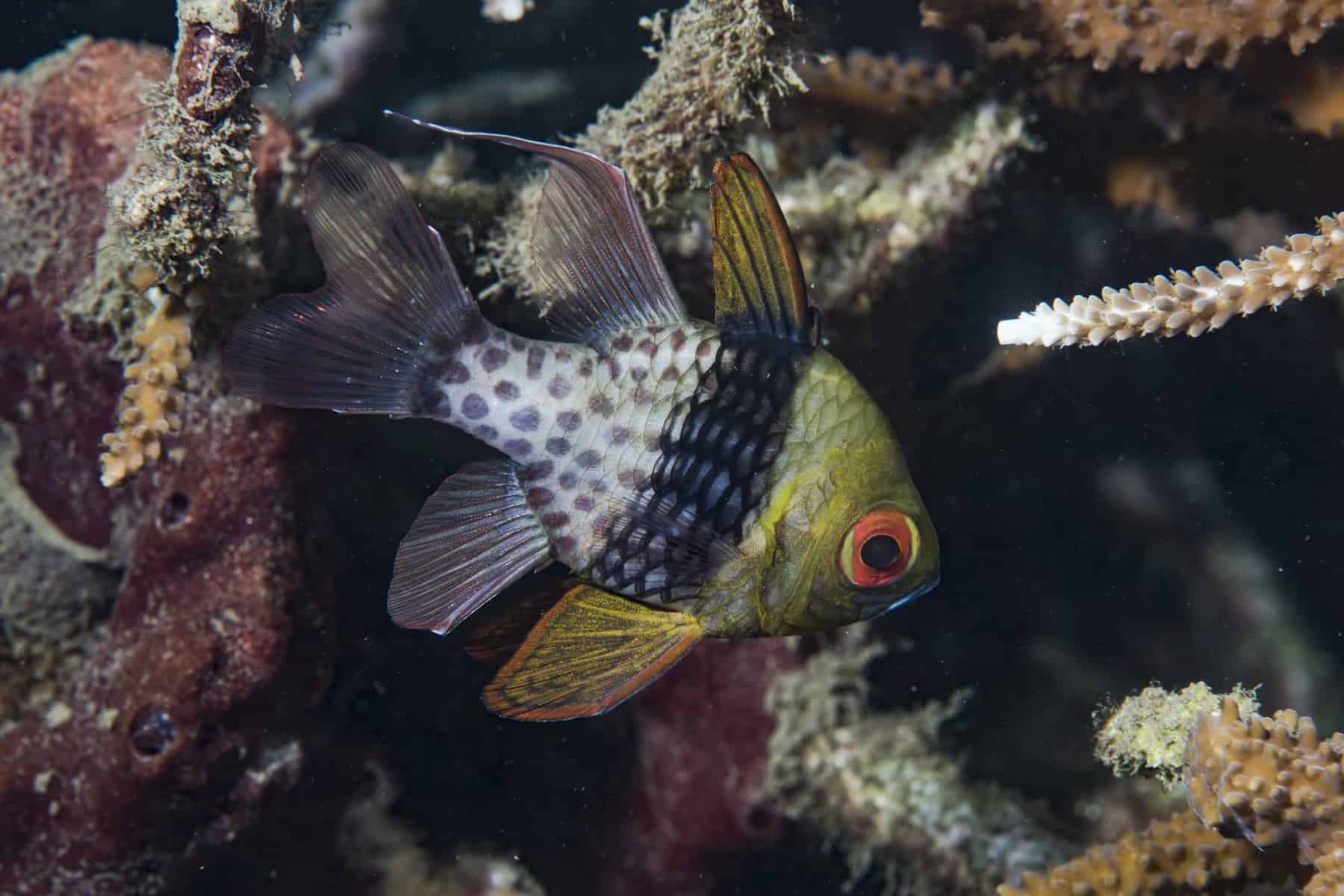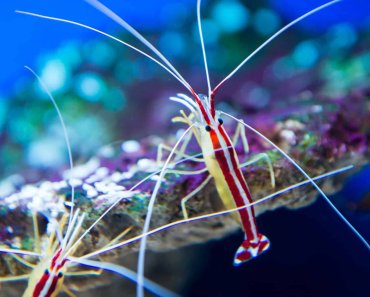Are you looking for a schooling species of saltwater fish? Your choices are few and far between.
Luckily, the Pajama Cardinal is perfect for a fish only with live rock (FOWLR) aquarium or a community reef tank setup. These fish are peaceful tank mates and are one of the few species that actively schools in the aquarium. On top of that, their care is relatively straightforward.
Keep reading to find out everything you need to know about Pajama Cardinals and how to keep them in your saltwater aquarium!
Name
Pajama Cardinalfish (Sphaeramia nematoptera), also sometimes known as Spotted, Coral, or Polkadot Cardinalfish, are named after their unique appearance.
These colorful fish have a yellow head followed by a vertical black stripe that leads to red and white polka dots. Up close, these polka dots can look just like pajama bottoms, earning them their name!
Scientifically, Pajama Cardinals come from a very small group of fish. The Sphaeramia genus only contains one other Cardinalfish species, the Orbiculate Cardinalfish (Sphaeramia orbicularis), which is not commonly found in the aquarium trade.
Natural habitat
Pajama Cardinalfish can be found throughout the Indo-Pacific and the Pacific Ocean around the Great Barrier Reef, Ryukyu Islands, and Tonga. They are located at shallow depths on coral reefs, usually tucked away in inlets and lagoons.
These fish can most notably be found around branching small polyp stony coral (SPS) species.
Identification
Pajama Cardinalfish stay relatively small, only growing to about 3-4 inches (7.6-10.2 cm). These fish have an interesting body type that could be compared to a freshwater Angelfish (Pterophyllum scalare) with a laterally compressed body and draping dorsal fins.
They also have exciting colors, as mentioned before. Pajama Cardinals are recognizable by their yellow heads, mid-vertical dark band, and white and red polka dots. Their eyes are usually bright orange and enlarged to help these nocturnal fish see at night.
Though these fish aren’t the most popular species to keep in the hobby, their unique appearance is unlike anything else available. The next closest-looking fish would be the more popular Banggai Cardinalfish.
Banggai Cardinalfish (Pterapogon kauderni)
Banggai Cardinals, also known as Kaudern’s Cardinal, come from very restricted regions of the Banggai Islands in Indonesia.
In seagrass ecosystems, they stay in considerably large groups of up to 60 individuals. Interestingly, they rely on the spines of sea urchins for shelter, unlike Pajama Cardinals that use corals to hide.
These two fish also differ significantly in appearance. Banggai Cardinals are plainer with silver bodies and black and white spots and stripes. They also grow slightly smaller, reaching mature sizes of about 3 inches (7.6 cm).
Besides appearance, Pajama Cardinals tend to be hardier than Banggai Cardinals. It is also worth noting that Banggai Cardinalfish are a threatened species primarily due to aquarium collection. Picking Pajama Cardinals for your tank instead might be more environmentally friendly.
Pajama Cardinal tank requirements
Pajama Cardinals are among the few saltwater fish species that can be kept in groups. It is recommended to keep at least three per tank.
As these fish are slow swimmers, they can be kept in most nano aquariums. At least a 40-gallon tank (151.4 L) is recommended for a small school and to allow room for other tank mates. These fish can be kept on their own and require a minimum tank size of at least 20 gallons (75.7 L) for themselves.
Pajama Cardinals are hardy fish that do not have any special needs and can be kept in standard FOWLR or reef conditions. Enough live rock should be available for ample hiding spaces; large colonies of SPS corals may be added by more advanced hobbyists to really see how they naturally interact with their surroundings.
Pajama Cardinals can be kept with hang on the back (HOB), canister, or sump filtration as long as ammonia levels and nitrites stay at zero ppm and nitrate remains manageable (<10 ppm). These fish need low flow areas in the aquarium to not be pushed around.
Regular changes are also needed to maintain the following water parameters:
- Temperature: 75 – 82° F (23.9-27.8° C)
- pH: 8.0 – 8.4
- Salinity: 1.023 – 1.026
- Alkalinity: ~8.0 dkH
Remember that although these numbers are ideal, a stable tank is much better than a volatile one.
Are pajama cardinals easy to keep?
Pajama Cardinals are relatively easy to keep. Many hobbyists believe that they are hardier than Banggai Cardinals, meaning they can better adapt to changes in their environment.
However, they are not as forgiving as other ‘easy’ aquarium fish, like clownfish, and stocking needs to be done with care. A Pajama Cardinal will often go missing for no reason, while others can live comfortably for several years.
Pajama Cardinal tank mates
The best tank mates for pajama cardinals are each other, though there are plenty of other options as well.
Some of these options include:
- Clownfish
- Tangs
- Angelfish
- Wrasses
- Blennies
- Gobies
They can also be kept with most invertebrates. Because they are a slower, more peaceful fish species, make sure to keep hungry crabs and shrimp fed.
Pajama Cardinal behavior

Pajama Cardinals are not the most exciting fish to have in the aquarium. For the most part, they stay in one area of the tank and hover in the water column. Because they’re nocturnal, they’ll be more active during evening hours.
Pajama Cardinalfish do best in groups, but there can be a chance of aggression; the weakest Cardinals will usually be cast out from the group and bullied. Males can be especially problematic when placed together, though this is unlikely in larger tanks.
It is also not uncommon for your Cardinalfish to fade in color overnight. In the morning, when the lights turn on, you might find a very pale or washed-out fish. Usually, this is no concern.
If the other fish in your community tank start to lose their color and/or start behaving weirdly, you might be dealing with velvet or another aquarium disease.
Are Pajama Cardinals reef-safe?
Yes, Pajama Cardinals are completely reef compatible. In fact, you might find them using the coral structures in your tank to hide and find food.
Can Pajama Cardinals jump out of your tank?
Cardinals are not known for jumping, but that doesn’t mean it’s impossible.
To best prevent any fish from jumping out of the aquarium, make sure to have a secure aquarium lid or netting. You want to allow for gas exchange but don’t want any gaps where your fish might be able to squeeze through.
Pajama Cardinal diet
Pajama Cardinals are a primarily carnivorous species and should never be used to treat an algae problem.
That said, they’re not picky about what they eat and will enjoy a selection of live, freeze-dried, and frozen food assortments. Some of their favorites will be brine shrimp, mysis shrimp, and bloodworms, though they can regularly be offered high-quality marine fish flake food or pellet food.
Breeding Pajama Cardinals
Both Pajama and Banggai Cardinals have been successfully bred in the aquarium hobby, which is especially good news for wild Banggai populations. These species are fascinating to breed as they are mouthbrooders.
Being a mouthbrooder means that these fish carry their fertilized eggs in their mouths for protection. The male can’t eat during this time, which is essential to keep in mind when preparing your fish to spawn.
The first step to breeding Pajama Cardinals is getting a male and female pair. This can be very difficult as there are few physical differences between males and females. The best way to get a Cardinalfish pair is to buy an already established one or buy a larger group of cardinals and wait for them to pair off independently.
Once a pair has been made, keep water quality up and provide high-quality food several times a day. This will help the female produce healthy eggs and prepare the male to go a couple of weeks without eating; it is typical for the male to eat some or all of the eggs and to lose some body mass.
You will know your fish are ready when the female starts to perform vibrating dances on either side of the male. The male will develop a distended jaw as the eggs incubate. During this time, continue to keep water quality up.
Once the eggs turn silver, they are ready to hatch. When you can see the fry in his mouth, it’s best to catch the male in a net. Due to the stress from being captured, he will spit out the fry, making it very easy to transplant them to another breeding tank.
At this point, feed small foods, like baby brine shrimp, to the juvenile fish until they are ready to be rehomed or added to the display aquarium.
In some cases, Pajama Cardinals will naturally breed on their own in the aquarium. In this case, the fry should also be removed to prevent them from being eaten or sucked up by filtration.
Conclusion
Pajama Cardinals are one of the most peaceful schooling fish available in the marine aquarium hobby. They can be kept in most saltwater fish tank setups and are one of the best beginner fish options for breeding.
If you have any questions about Pajama Cardinals, Banggai Cardinals, or have had success breeding either of these species, don’t hesitate to leave a comment below!


























